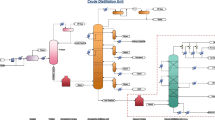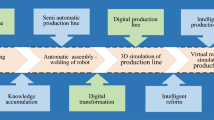Abstract
Energy consumption is an important quality index in the production of seamless tubes. The complex factors affecting energy consumption make it difficult to build its mechanism model, and optimization is also very difficult, if not impossible. The piercing process was divided into three parts based on the production process, and an energy consumption prediction model was proposed based on the step mean value staged multiway partial least square method. On the basis of the batch process prediction model, a genetic algorithm was adopted to calculate the optimum mean value of each process parameter and the minimum piercing energy consumption. Simulation proves that the optimization method based on the energy consumption prediction model can obtain the optimum process parameters effectively and also provide reliable evidences for practical production.
Similar content being viewed by others
References
Cavaliere M, Goldschmit M, Dvorkin E. Finite Element Analysis of Steel Rolling Processes [J]. Computers and Structures, 2001, 79(2): 2075.
WANG Bei-ming. Quality of Hot-Rolled Steel Tube [M]. Beijing: Metallurgical Industry Press, 1987 (in Chinese).
PANG Yu-hua, ZHOU Zhong-min, CHENG You-yi. Influence of Plug Configuration on Wall-Thickness Uniformity and Energy Consumption During Shell Piercing [J]. Steel, 1991, 41 (5): 48.
Chiang Leo H, Leardi Riccardo, Pell Randy J. Industrial Experiences With Multivariate Statistical Analysis of Batch Process Data [J]. Chemometrics and Intelligent Laboratory Systems, 2006, 81(4): 109.
Zhang Yale, Dudzic Michael. Industrial Application of Multivariate SPC to Continuous Caster Start-up Operations for Breakout Prevention [J]. Control Engineering Practice, 2006, 14 (11): 1357.
Leea Dae Sung, Parka Jong Moon. Adaptive Multiscale Principal Component Analysis for On-Line Monitoring of a Sequencing Batch Reactor [J]. Journal of Biotechnology, 2005, 116 (3): 195.
Chen Jung-hui, Chen Hsin-Hung. On-Line Batch Process Monitoring Using MHMT-based MPCA [J]. Chemical Engineering Science, 2006, 61(5): 3223.
LI Lian-shi. Steel Tube Plastic Deformation Theory [M]. Beijing: Metallurgical Industry Press, 1985 (in Chinese).
LI Yuan, WANG Gang. A Study on Dynamic Time Warping [J]. Journal of Shenyang Institute of Chemical Technology, 2002, 16(1): 44 (in Chinese).
Holland J H. Adaptation in Natural and Artificial Systems [M]. Michigan; The University of Michigan Press, 1975.
Author information
Authors and Affiliations
Corresponding author
Additional information
Foundation Item: Item Sponsored by National Natural Science Foundation of China (60674063)
Rights and permissions
About this article
Cite this article
Xiao, D., Pan, Xl., Yuan, Y. et al. Modeling and optimization for piercing energy consumption. J. Iron Steel Res. Int. 16, 40–44 (2009). https://doi.org/10.1016/S1006-706X(09)60025-X
Revised:
Published:
Issue Date:
DOI: https://doi.org/10.1016/S1006-706X(09)60025-X




